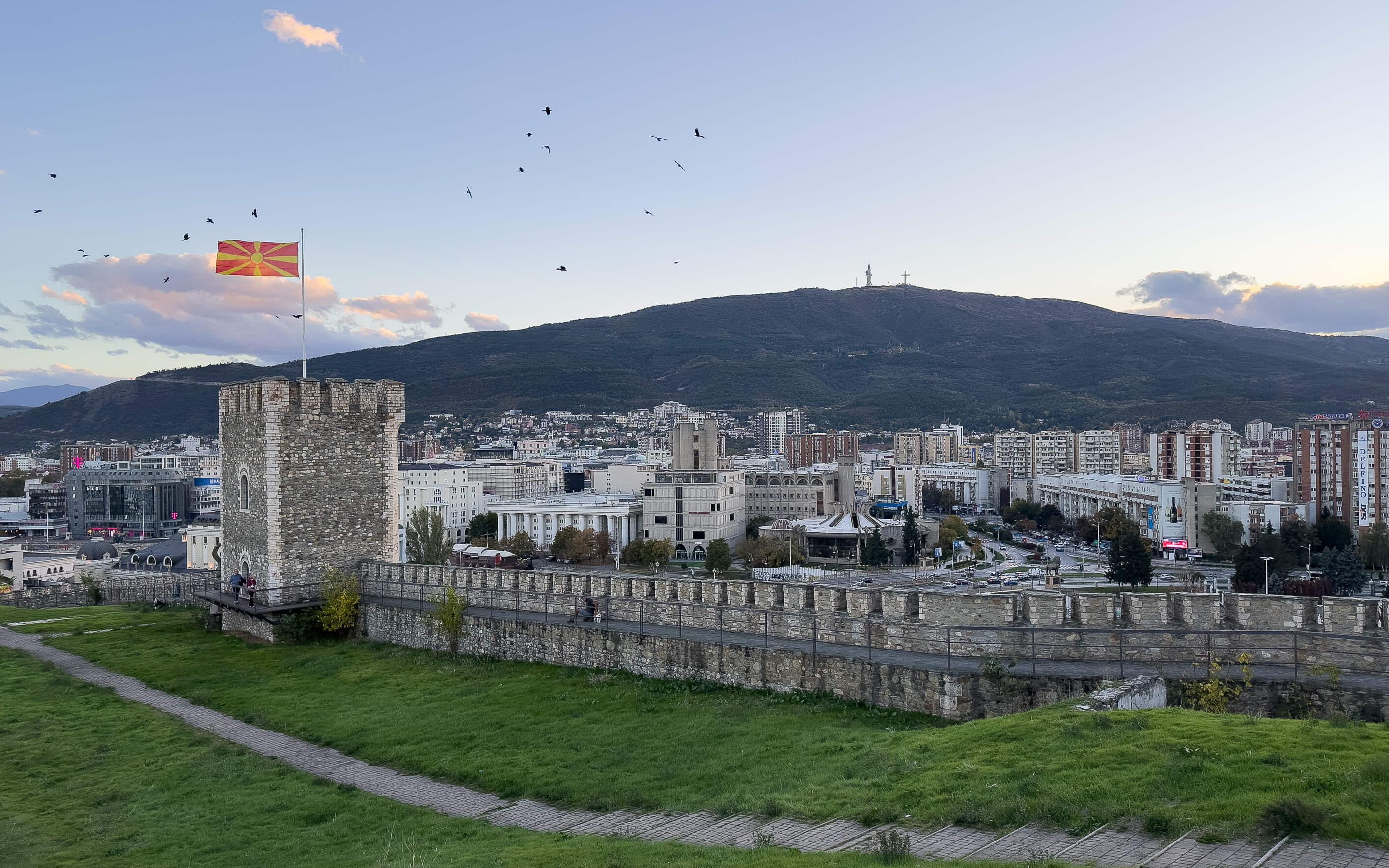
.svg)
Skopje is a city full of contrasts and still a true insider tip for a relaxed city trip within Europe.
The capital of North Macedonia and the largest city in the country, with around half a million inhabitants, offers a fascinating mix of Soviet-era apartment blocks, historic buildings and so-called “pseudohistorical” architecture. This contrast is exactly what makes Skopje so interesting and gives the city its own unique charm.
Unlike major cities such as Budapest, Zagreb or Warsaw, which have long been discovered by mass tourism, Skopje still feels pleasantly calm.
You will not find the big, classic attractions here that usually lead to sightseeing stress.
Instead, the city invites you to stroll around at your own pace, enjoy a coffee in one of the many cafés and take in the rhythm of local life.
At the same time, North Macedonia’s capital is becoming more modern every year.
New cafés, trendy bars, upscale restaurants, contemporary buildings and large shopping centers are increasingly shaping the cityscape.
Thanks to its international airport, Skopje is also the ideal starting and end point for a road trip through North Macedonia.
We also visited Skopje during our round trip and were surprised by how diverse the city is, but also by how much still needs to be done if the country is to join the EU one day.
This guide shows you the most important sights and highlights in Skopje and explains why a visit is truly worthwhile.

BEST TIME TO VISIT SKOPJE
Skopje can be visited at any time of the year because each season has its own charm.
In spring, nature comes back to life and the parks as well as the riverbanks of the Vardar begin to turn green and bloom.
In summer, life moves outdoors. Street cafés are full, the squares are lively and people stay outside until late at night. However, temperatures can get very hot during this time.
In winter, it often becomes very cold, but around Orthodox Christmas, which is celebrated in early January, Skopje shines with festive lights and decorations.
In autumn, the temperatures are pleasantly mild, making it ideal for sightseeing or long walks through the old town and along the river. At the same time, the leaves turn warm shades of yellow and red, giving the city a special atmosphere.
We visited at the end of October and experienced exactly that: a golden autumn with mild temperatures, plenty of sunshine and beautiful colors.
This is why we highly recommend autumn as a great time to visit Skopje.
HOW MANY DAYS TO STAY IN SKOPJE
It depends on how much you want to see and experience. Here is a general guideline:
- Stay 1 day in Skopje if you want to visit the most important sights such as the Old Bazaar, Macedonia Square and Kale Fortress.
- Stay 2 days in Skopje if you prefer to take your time, stroll through the city at a relaxed pace and do some shopping in one of the malls.
A trip to Mount Vodno or the impressive Matka Canyon is also well worth it. - Stay 3 days or more in Skopje if you want to take a day trip to Pristina, the capital of Kosovo, or go hiking in the surrounding mountains.
By the way, we visited Skopje as part of our North Macedonia and Kosovo road trip. If you want to know which other highlights the country has to offer and what experiences we made along the way, take a look at the following articles:
- North Macedonia & Kosovo Road Trip – Route, Tips and Highlights
- Pristina – Top Sights, Highlights & Travel Tips for Kosovo’s Capital
HOTELS AND ACCOMMODATION IN SKOPJE
We chose the Luxury Apartment at Diamond Center, which we booked through booking.com.
The accommodation is located in one of Skopje’s most modern high-rise complexes, just a few minutes’ walk from Macedonia Square and therefore very central.
The modern apartment offered plenty of space, was stylishly furnished and had a balcony with a great view. The private and free parking space for our rental car was also very convenient.
The self check-in process went smoothly, and we were very happy with our stay overall. For these reasons, we can highly recommend the Luxury Apartment at Diamond Center.
HOW TO GET TO SKOPJE
The fastest way to reach Skopje is by plane. Skopje International Airport (SKP) offers regular direct flights from many European cities.
Low-cost airlines such as Wizz Air frequently provide affordable fares, and you can easily search for suitable connections on websites like skyscanner.com.
If you are traveling from outside Europe, you will usually need to connect through major hubs such as Istanbul, Vienna, Zurich or Frankfurt, which offer frequent flights to Skopje.
The average flight time from Central Europe is around 1.5 hours, while flight durations from other parts of the world vary depending on layovers and routing.
Although North Macedonia is not a member of the European Union, entry is straightforward for many nationalities.
Travelers from the EU, the United Kingdom, the United States, Canada, Australia and numerous other countries can enter visa free for short stays.
A valid passport is required for most travelers. EU citizens may also enter with a national ID card. As always, it is recommended to check the latest entry requirements before traveling.
The easiest and fastest way to get from the airport to the city center is by taxi. The ride usually takes around 30 minutes, depending on traffic.
GETTING AROUND SKOPJE
The center of Skopje and most of its main sights, such as Macedonia Square, the Stone Bridge, the Old Bazaar and Kale Fortress, are located close to one another, which makes it easy to explore everything on foot.
Only for destinations outside the city center, such as Matka Canyon, Mount Vodno or the shopping malls, it is recommended to use a rental car or a taxi.
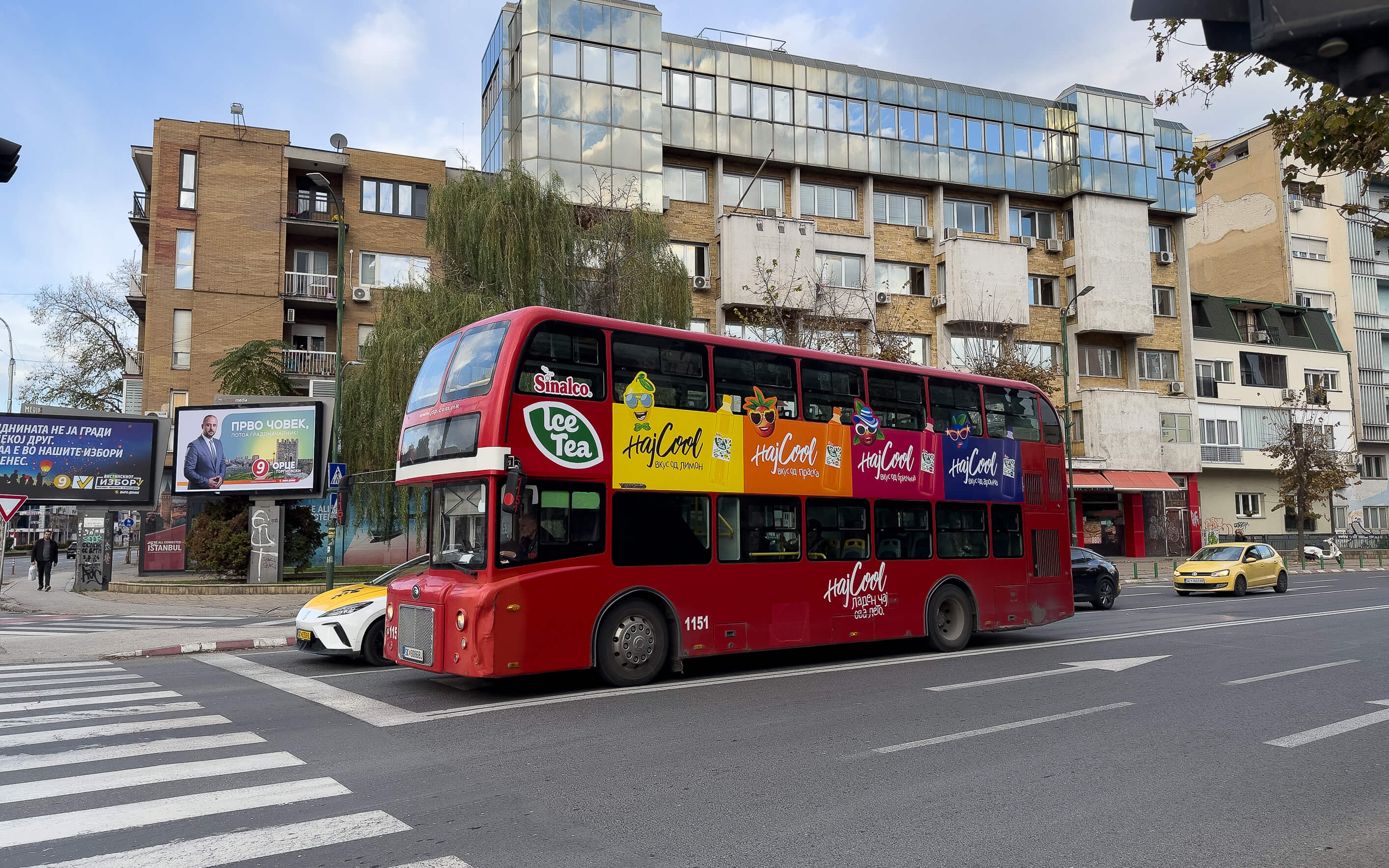
THE SIGHTS IN SKOPJE
KALE FORTRESS
A great way to start your city trip is with a visit to Kale Fortress, as it is called in Macedonian.
This sixth-century fortress sits on the highest point within the city center and offers a wonderful first overview of Skopje. From up here you can take your time and let the city sink in.
Under Byzantine, Ottoman and later Yugoslav rule, the fortress was expanded, damaged and rebuilt several times over the centuries.
Its current form is largely shaped by the Ottoman period. Even in the twentieth century, during the time of the Yugoslav kingdom, the complex continued to serve military purposes.
Today you can walk along the old walls and through the green areas inside while enjoying panoramic views of the city. The atmosphere is especially beautiful at sunset.
You can reach the fortress within just a few minutes on foot from the city center. The climb is easy and not steep. Entry is free.
Opening hours vary depending on the season. During our visit at the end of October, in the autumn and winter season, the complex closed around 6 pm at dusk.


OLD BAZAAR OF SKOPJE
Just a few minutes’ walk from Kale Fortress lies the Old Bazaar of Skopje, known in Macedonian as Stara Čaršija. It forms a fascinating contrast to the rest of the city.
Instead of tall apartment blocks, you will find a predominantly Muslim neighborhood with small houses, narrow streets and an oriental atmosphere.
The history of the Old Bazaar goes back many centuries. During the Ottoman period, the district experienced its heyday.
Traders from all over the world came here to sell fabrics, spices, jewelry and handmade goods.
Today, the Old Bazaar is a charming blend of tradition and modern life.
You can still find a few small workshops where goldsmiths and other artisans work, but most of the area is now characterized by jewelry stores, shops selling festive clothing, bag shops and souvenir stores. Between them, cozy cafés and traditional restaurants invite you to sit down and enjoy the atmosphere.
Take your time to wander through the narrow alleys and soak up the vibrant energy of the area.
We think it is worth visiting the Old Bazaar both during the day and after dark to experience its different moods.
In the late morning it is still relatively calm, while in the late afternoon and evening the quarter really comes to life.


MOSQUE AND HAMAM
What would a predominantly Muslim neighborhood be without a mosque and a Turkish bath?
The historic Mustafa Pasha Mosque from the fifteenth century sits slightly above the bazaar.
The calls of the muezzin echo across the entire quarter and, in our opinion, add an even more authentic and oriental atmosphere.
At the edge of the bazaar you will find the Daut Pasha Hamam, a former Turkish bath that is now used as an art gallery.
BIT PAZAR
A real highlight is Bit Pazar, which is directly connected to the Old Bazaar. If you thought the Old Bazaar was already bustling, wait until you get here.
Inside the market hall you will find fresh fruits, vegetables, spices and local specialties. It is the perfect place to mingle with locals and get an authentic glimpse into everyday life.
Outside the hall, numerous market stalls line the streets, selling clothing, bags, suitcases, toys and household items.
Good to know: most of the “brand-name” products are counterfeits, so it is best to take a closer look before buying anything.
Whether you want to buy something in the Old Bazaar or at Bit Pazar, bargaining is simply part of the experience.
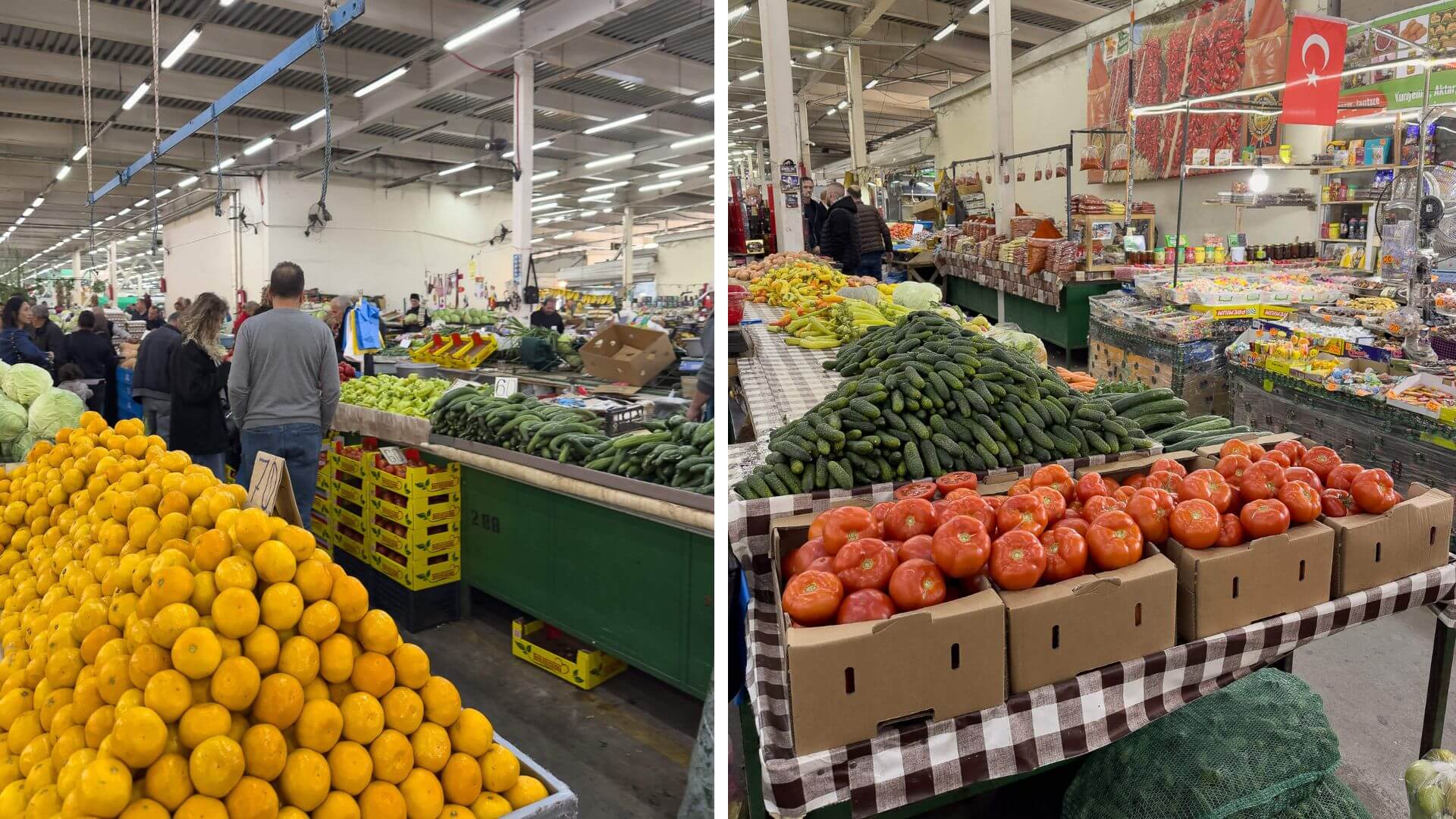
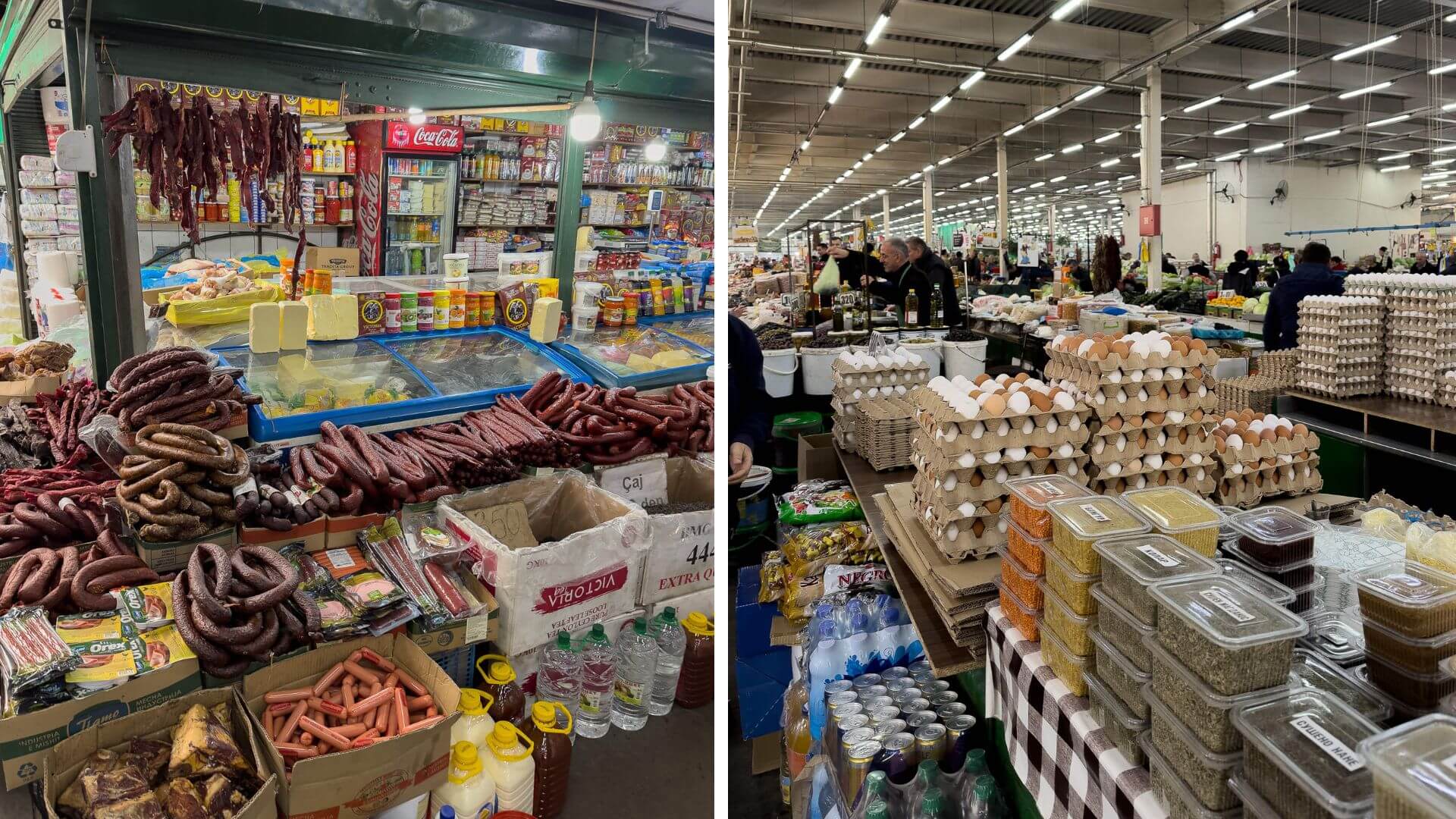

MACEDONIA STREET
During your sightseeing tour of Skopje, you will sooner or later find yourself on the pedestrian zone known as Macedonia Street.
This lively street connects Macedonia Square (more on that in a moment) with the old railway station, which today houses the Museum of the City of Skopje.
Along Macedonia Street you will find cafés, restaurants, boutiques and small shops.
On sunny days, the street cafés fill with people enjoying a drink or a bite to eat while watching the world go by.
In addition to numerous shops and places to eat, the street is also home to several interesting sights.
These include the Mother Teresa Memorial House, which commemorates the life of the famous Nobel Peace Prize laureate, as well as the Orthodox Church of Saints Constantine and Helena, whose modern architecture forms an appealing contrast to the surrounding buildings.
You will also come across several statues and monuments along Macedonia Street, including the Monument of the Big Bull, the Shoe Shiner statue and the Monument of Tsar Samuel.
By the way, during your tour of Skopje you will probably notice many more statues. The city has quite a lot of them.
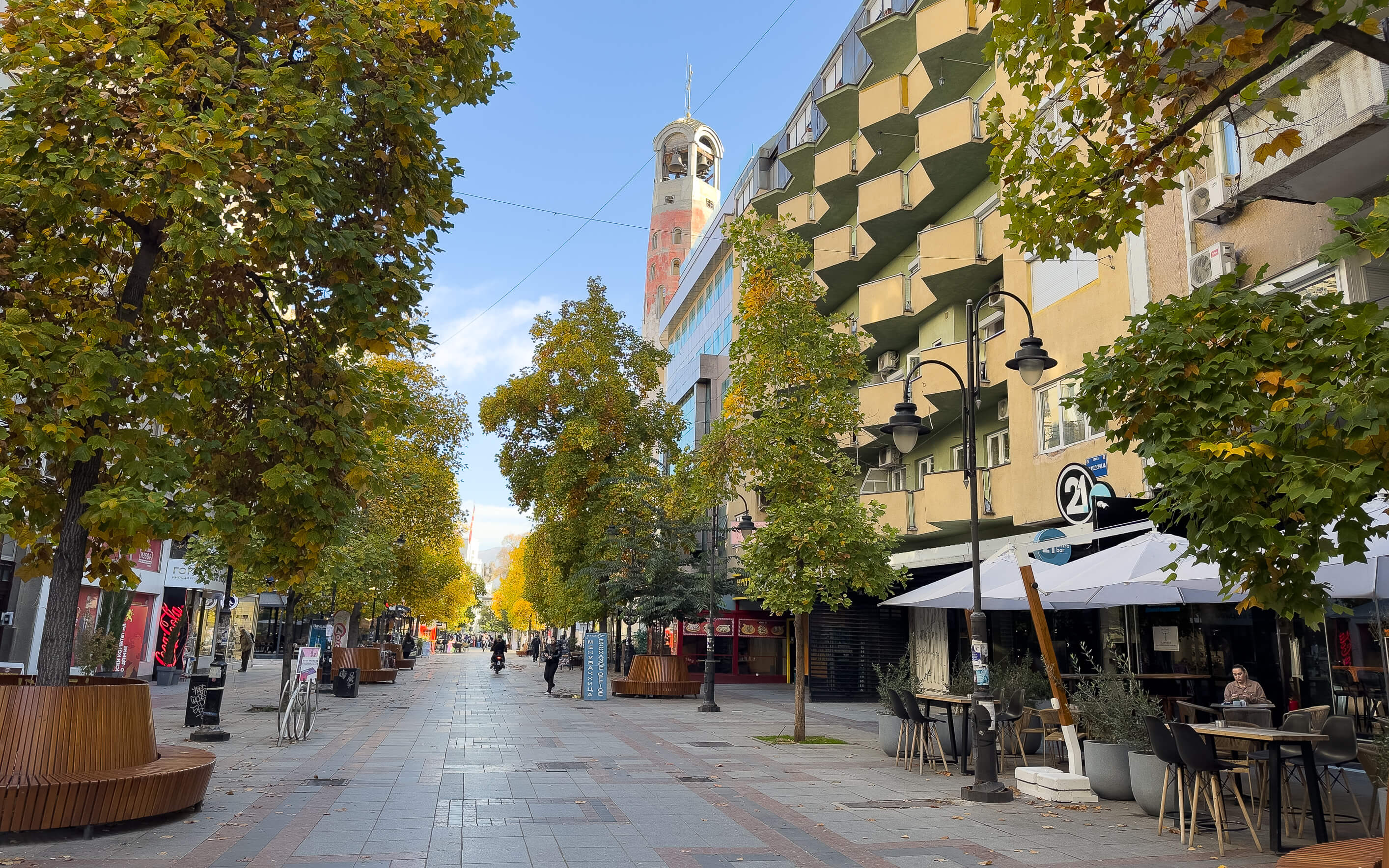

MACEDONIA SQUARE
At the end of Macedonia Street you reach Macedonia Square, the heart of Skopje.
This large square is a popular meeting place for both locals and visitors. At its center stands the approximately 22-meter statue of Alexander the Great, surrounded by an impressive fountain.
It is especially beautiful in the evening when the fountain is illuminated with colorful lights.
Just a few meters from the fountain you will find another highlight, the Porta Macedonia, which resembles the Arc de Triomphe in Paris.
If you are wondering why the square and its surroundings look so different from the rest of the city and have little in common with typical Balkan charm, the explanation lies in the controversial and extremely costly urban renewal project “Skopje 2014.”
The former prime minister Nikola Gruevski wanted to transform Skopje into a kind of Baroque-style city as a symbol of the country’s renewed self-confidence and national identity.
Between 2010 and 2014, numerous neoclassical buildings, monuments and two bridges across the Vardar River were constructed as part of this project.
Today they dominate the area around the square.
The government that followed Gruevski largely distanced itself from the project.
Not surprisingly, the initial budget was set at 80 million euros, but costs are estimated to have exceeded 700 million euros, accompanied by corruption allegations.
During our visit we felt that very little money is now being invested in maintaining these buildings.
While walking along the structures on the opposite side of the river, such as near the opera, we noticed that many façades are already crumbling again and that upkeep is limited.
The once elaborate buildings now appear somewhat neglected and leave a mixed impression.
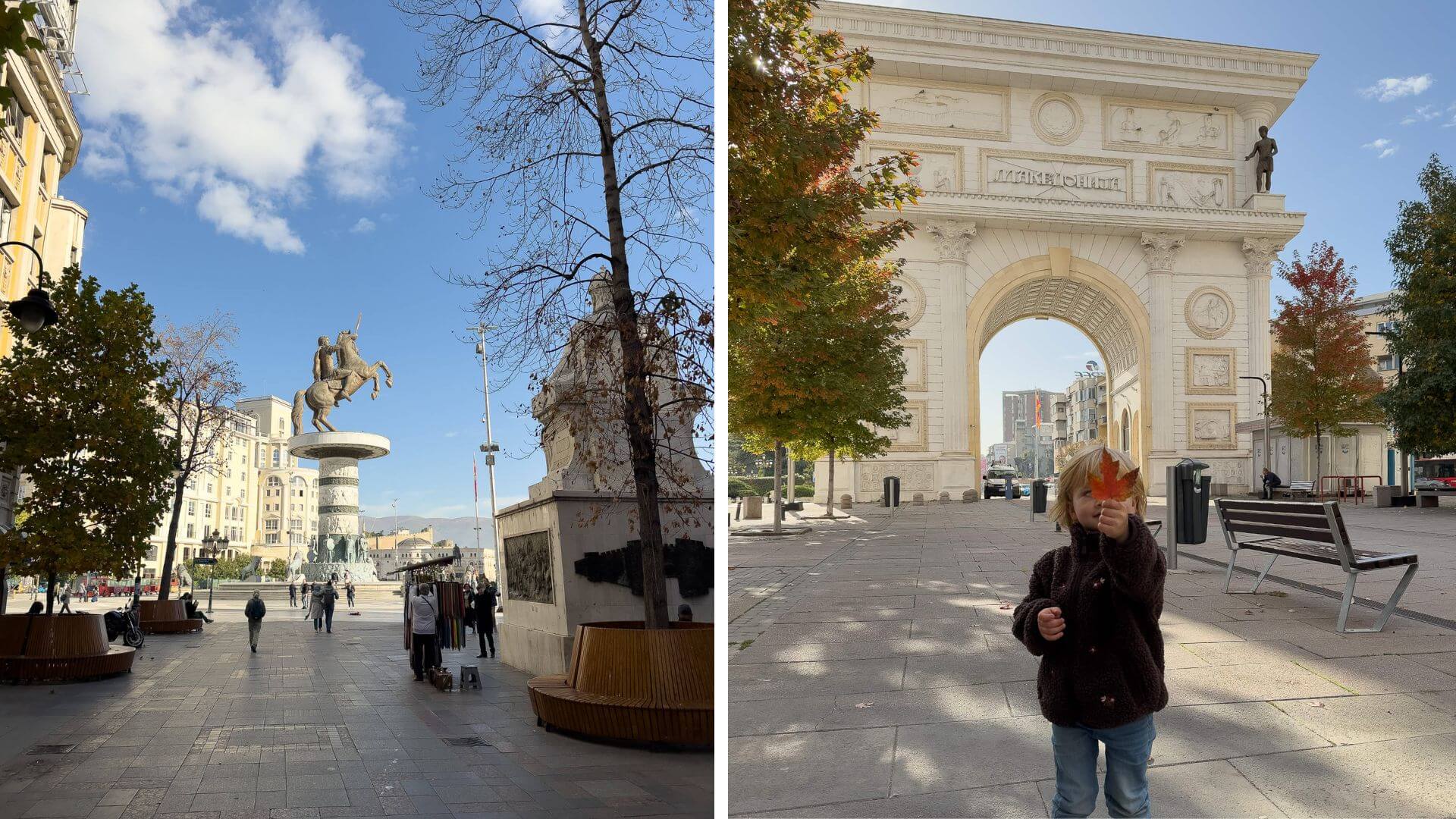

STONE BRIDGE
A complete contrast to Macedonia Square is the historic Stone Bridge, which spans the Vardar River.
It connects Macedonia Square with the Old Bazaar, linking the modern and historical parts of the city.
The bridge is about six meters wide and around two hundred meters long.
With its twelve narrow arches, it is one of the oldest structures in Skopje. It was built in the fifteenth century during the Ottoman period.
Over the centuries, the bridge has been damaged and restored several times, yet it has always remained one of Skopje’s central landmarks.
It suffered severe damage during the devastating 1963 earthquake but was later rebuilt true to its original form.
You will get the best view of the bridge from the riverbank just below it.

BRIDGE OF CIVILIZATIONS AND BRIDGE OF ART
Just a few meters from the historic Stone Bridge you will find a much newer structure, the Bridge of Civilizations.
Its railings are made of marble, and every few meters a statue of an important figure from North Macedonian history stands on either side.
There are also numerous lanterns which, in our opinion, give the bridge a rather overloaded and slightly kitschy appearance.
Still, or perhaps for that very reason, it is an interesting photo spot and fits well into the overall look of the area.
The Bridge of Art is the third and final bridge crossing the Vardar River in this section.
It is similar to the Bridge of Civilizations but differs in that its statues depict well-known Macedonian artists, musicians and writers.

DEBAR MAALO – THE CITY’S HIP NEIGHBORHOOD
A little outside the city center, but only about a 15 to 20 minute walk away, lies the neighborhood of Debar Maalo.
It is considered one of the hippest areas in the city and is especially popular with locals.
Alongside many recommended restaurants and cozy cafés, you will also find bars and clubs that make the district lively, especially in the evenings.
If you are looking for good food, we can recommend the restaurant Špajz as well as Skopski Merak.
Both are slightly more expensive but offer fantastic Macedonian cuisine in a beautiful setting.
Since they get very busy in the evenings, it is worth making a reservation in advance, either online or by phone.
Debar Maalo also has plenty to offer during the day. Particularly worth seeing is the Green Market, a small and authentic market with fresh regional products.
It is a great alternative to the better-known Bit Pazar.
Right next to the neighborhood is Skopje City Park. If you are looking for a break in nature or want to escape the noise of the streets for a while, this is the perfect place.
The park is also home to the Skopje Zoo, which is a nice destination for families with children and offers a quieter escape from the busy city.
EAST GATE MALL – SHOPPING IN SKOPJE
Also located slightly outside the city center is East Gate Mall, the largest and most modern shopping mall in North Macedonia.
If you need a break from sightseeing during your stay in Skopje, are looking for an alternative on rainy or extremely hot days, or simply feel like doing some shopping, this is the perfect place.
East Gate Mall has more than 200 stores, including many well-known international brands such as Zara, Nike, Reserved, Massimo Dutti and many more.
In addition, the large food court offers a wide selection of fast food restaurants and cafés.
East Gate Mall is open daily, including Sundays, from 10:00 am to 10:00 pm.

WALK ALONG THE VARDAR RIVER
If you are looking for a break from the busy streets and want to be a little active during your stay, you can take a relaxing walk along the banks of the Vardar River.
In the evening, when the city lights reflect on the water, the atmosphere is especially beautiful.
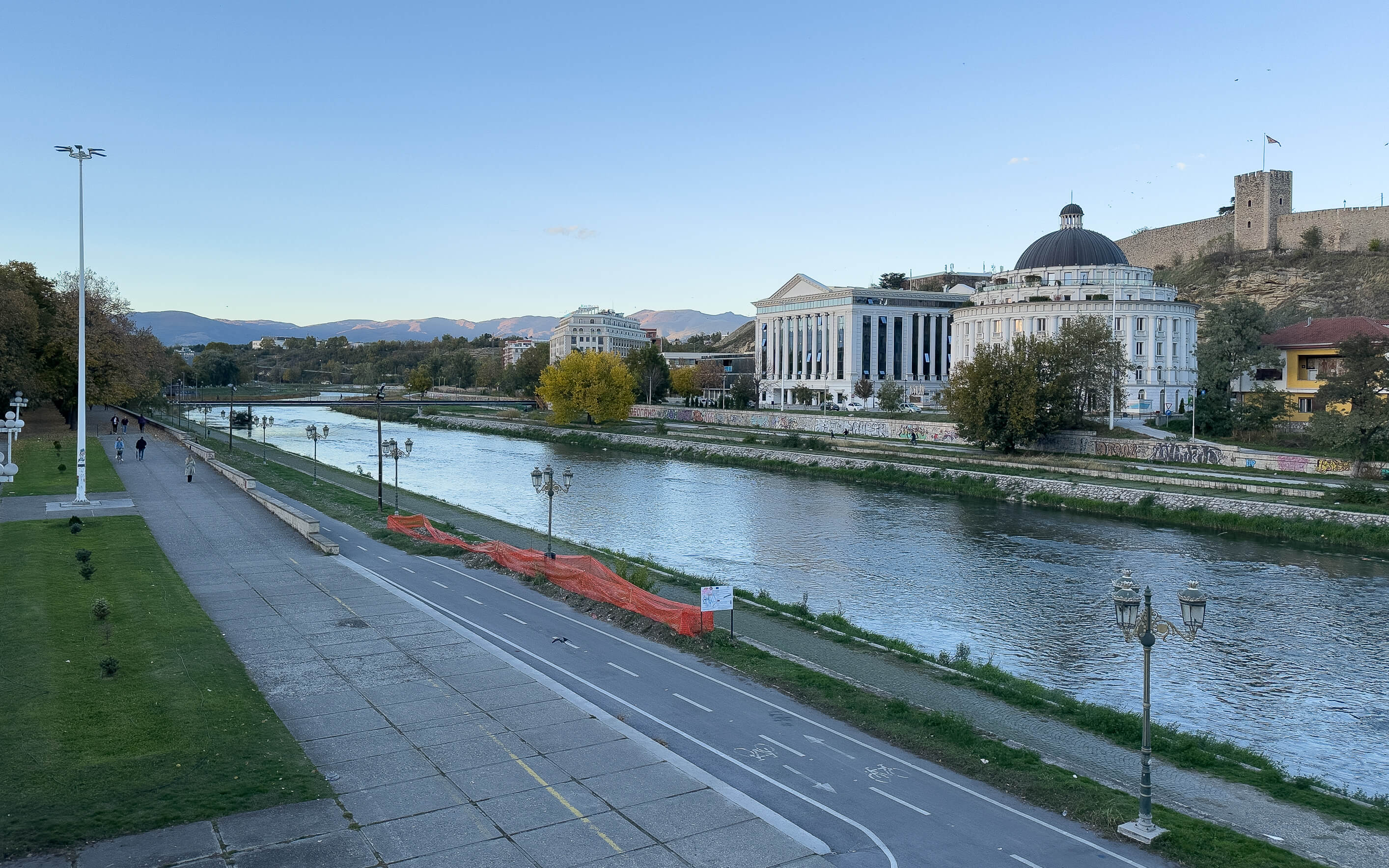

VODNO – SKOPJE’S MOUNTAIN
Only about a 15 minute drive from Skopje’s city center lies Mount Vodno, often referred to as Skopje’s local mountain due to its close proximity.
Its highest point is the Krstovar peak, which reaches an elevation of 1,066 meters.
You can reach the summit easily by cable car. If you prefer a more active option, you can hike to the top along one of the trails.
These start either directly in the city center or at the visitor parking area on Middle Vodno (Sredno Vodno).
Depending on the route and your pace, the ascent takes between one and three hours and leads through dense forests with beautiful views of Skopje along the way.
At the top you will find the impressive Millennium Cross, a 66 meter high cross that you have likely seen from the city center already.
From the summit you can enjoy fantastic panoramic views over Skopje and the Vardar Valley.
The atmosphere is especially beautiful at sunrise or sunset when the warm light colors the landscape in golden tones.
At the top there is also a small bistro offering drinks and snacks, as well as a playground and several viewing platforms with seating.
Admittedly, some parts of the area feel a bit outdated, but the breathtaking view over the city makes the trip absolutely worthwhile.
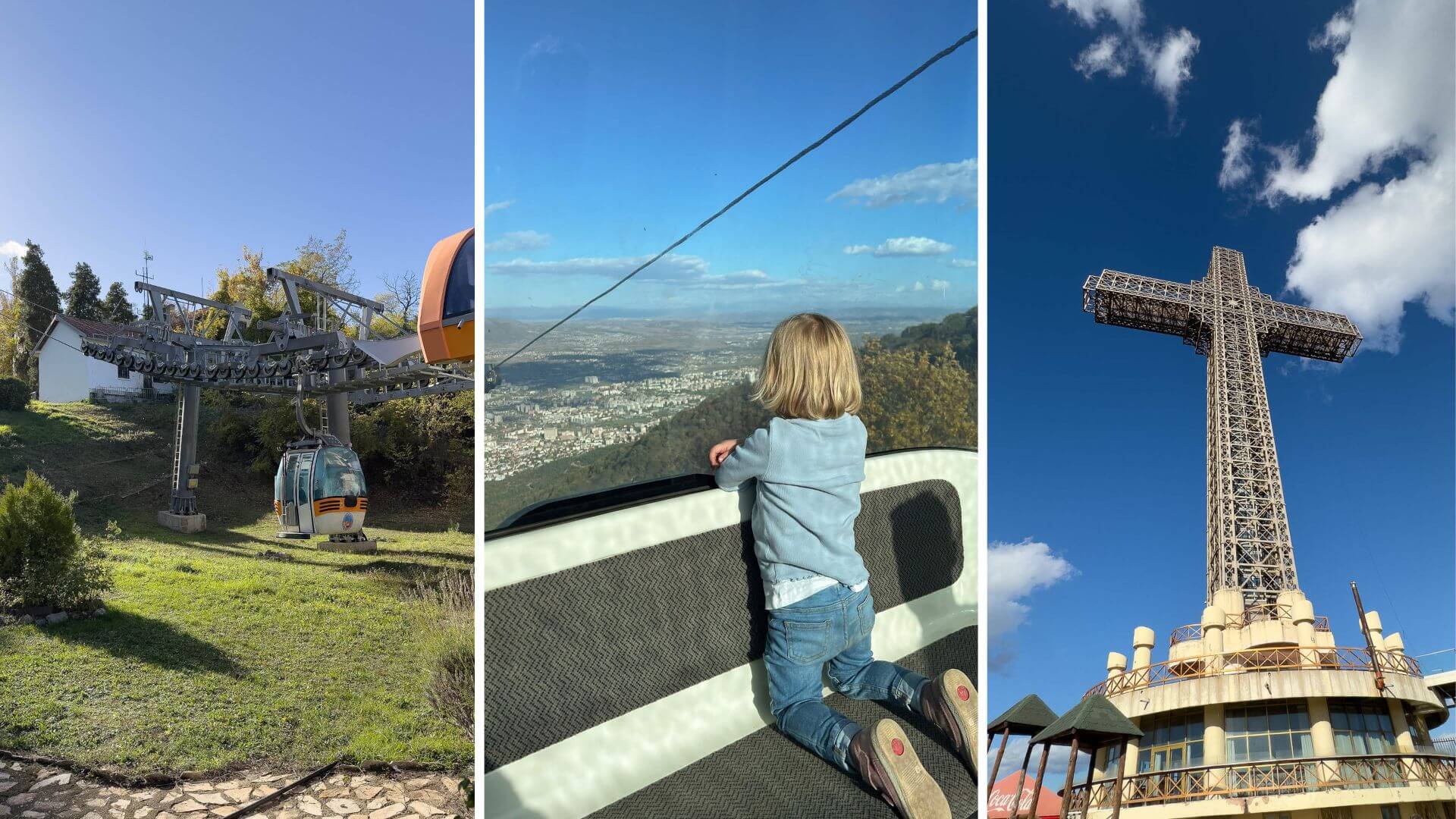
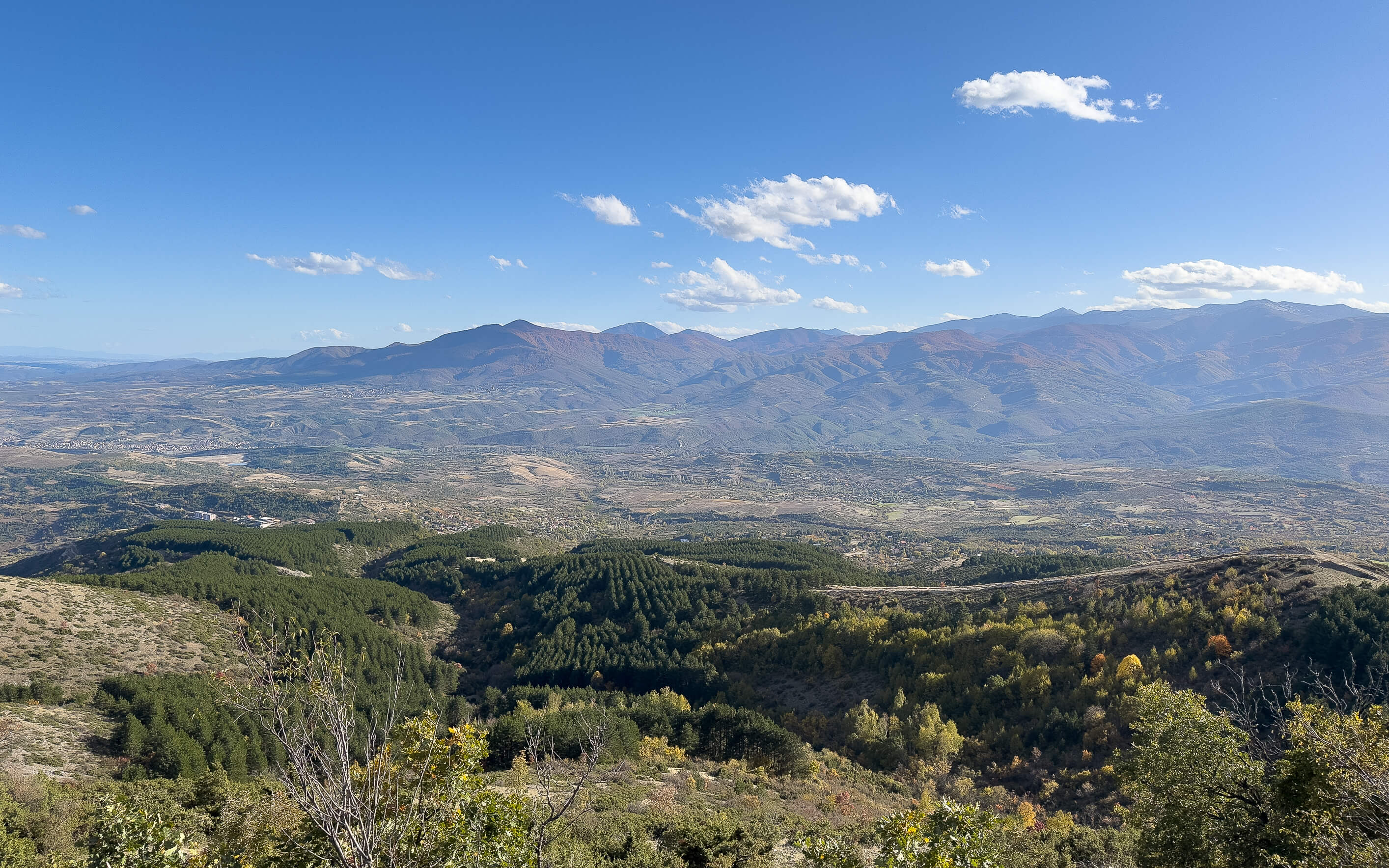

MATKA CANYON
Only about a 30 minute drive from the center of Skopje lies one of North Macedonia’s most beautiful natural highlights, the impressive Matka Canyon.
It is perfect for a half-day or full-day trip from Skopje.
Or you can do what we did and stay overnight directly at the canyon in the only hotel in the area, Canyon Matka Hotel, which we can highly recommend.
During the summer months, the canyon can get very crowded. The narrow path leading to the two boat docks runs along a steep rock face, which often causes bottlenecks and congestion.
Since we stayed overnight, we were able to enjoy the area both in the evening and early in the morning in complete peace.
During these times, the gate to the canyon area is open only for hotel guests.
It is perfect for taking in the impressive natural scenery without crowds or for exploring the somewhat challenging trail along the cliffs almost entirely on your own.
You can find a detailed report about our stay in our article North Macedonia & Kosovo Road Trip – Route, Tips and Highlights.
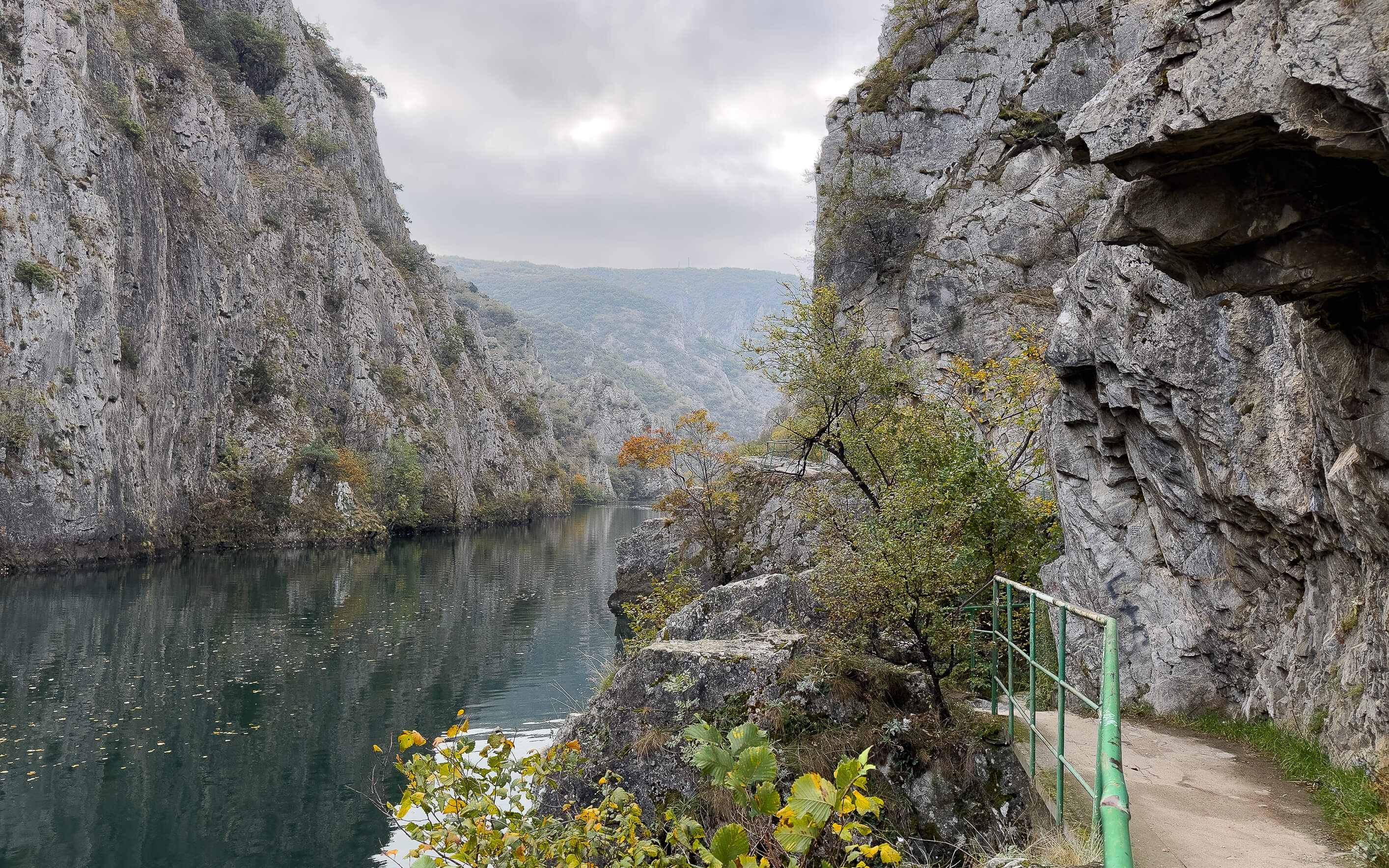
DAY TRIP TO PRISTINA (KOSOVO)
Only about an hour’s drive from Skopje lies Pristina, the young and diverse capital of Kosovo. It is still a real insider tip among Balkan cities.
You can find out which sights and highlights await you there in our post Pristina – Top Sights, Highlights & Travel Tips for Kosovo’s Capital.
The border crossing between North Macedonia and Kosovo is usually very straightforward. We entered with our rental car booked through DiscoverCars.
When picking up the car, we informed the rental company that we planned to cross the border.
This required an additional fee of about 35 euros, and that was it. At the border, our IDs were checked briefly and we were able to continue our journey immediately.
If you prefer to join a guided tour to the neighboring country, you can conveniently book one here: Day trip to Kosovo.
SKOPJE AND THE ISSUE OF WASTE
This is a topic we want to address separately, because for someone from Western Europe seeing it for the first time, it can be quite a shock.
North Macedonia, like its neighboring countries Albania, Serbia and Bulgaria, has a general waste problem.
You will find trash scattered in nature, and we are not talking about a few plastic bottles or bags, but in some cases entire piles of garbage.
The main reason is an underdeveloped waste management system that does not function in the way many visitors might be used to at home.
In addition, awareness about proper waste disposal is lacking among many locals, especially among the older generation. As a result, rubbish often ends up in nature or along the roadside.
In Skopje, this issue was particularly noticeable to us: not only in residential neighborhoods and along the riverbanks, but also in many other parts of the city, where large amounts of waste can be found. Even the public bins are often overflowing or emptied too infrequently.
Despite this, there are positive developments that give hope.
More and more local initiatives and environmental projects are working to create a cleaner city and raise awareness about waste management.
As a traveler, you can also contribute by disposing of your waste properly, using reusable water bottles or bags, and making sure not to leave anything behind during excursions into nature.

THIS ARTICLE WAS NOT ENOUGH FOR YOU? YOU WANT EVEN MORE TIPS, INSPIRATION AND SIGHTS FOR YOUR NORTH MACEDONIA TRIP? THEN MAKE SURE TO CHECK OUT OUR OTHER ARTICLES:
- North Macedonia & Kosovo Road Trip – Route, Tips and Highlights
- Traveling North Macedonia with a Baby and Toddler – Tips and Our Experience
USEFUL LINKS & RECOMMENDED TRAVEL GUIDES FOR YOU
- Discover the best accommodations
- Find affordable flights at skyscanner.com
- Find affordable rental cars at DiscoverCars
- The best Travel Guides for North Macedonia
- Unique Excursions to Experience in North Macedonia
Note: This blog post contains our personal recommendations in the form of so-called affiliate links. If you book or purchase something through these links, we earn a small commission. There is absolutely no change to the price for you.

.svg)
.svg)
.svg)



